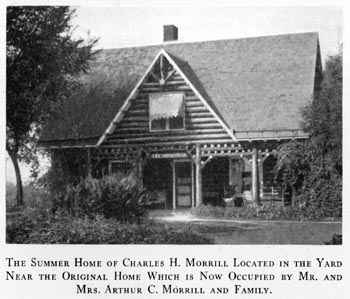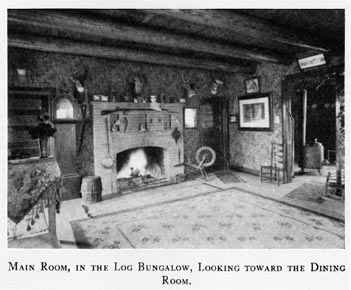[122]
THE MORRILLS AND REMINISCENCES


|
© 2002 for the NEGenWeb Project by Pam Rietsch, Ted & Carole Miller.
|
||||
NEGenWeb Project
Resource Center
On-Line Library
industrious that the traveler must admire them. The market places are beautiful in the extreme; they are decorated with flowers and the vegetables of different colors are so arranged as to attract attention. The water in Lac Leman is as blue as the sky and both were more vivid than I had ever seen before.
After enjoying Lausanne for a week we went to Montreux, located on a point of land running out quite a distance into Lac Leman. The Castle of Chillon stands on a little island, about fifty feet from the shore, connected by a bridge. Montreux is built along the shores of the lake for some distance. The land rises, very rapidly so that a large part of the city is far above the water. Funicular railroads are common; they climb steep mountain grades and yield the traveler magnificent views of the lakes and surrounding country.
From Montreux we went across the mountains to Interlaken. All Switzerland is picturesque and it is difficult to decide which part is the most beautiful. The peak of the Jungfrau is plainly seen from Interlaken. This city is the center for wood carving which is plainly an industry of importance. Many objects are beautifully carved out of wood, the Edelweiss, the bear, wild boar, and chamois being favorite subjects. While at Interlaken I had the good fortune to meet Mr. Egger, one of the firm of Egger und Brudders, extensive dealers in carved furniture and other Swiss carvings of all kinds. Mr. Egger spoke English fluently, and had resided five years in the State of Kansas,
[119]
U. S. A. Through his acquaintance I gained admission to several Swiss homes, among them the home of a millionaire. This man was the son of a poor family, but as he grew older he developed into a shrewd trader in different lines. When I met him he was in one of his shops where carved furniture was manufactured, and like all other working men was clad in overalls. All this work is done by hand, the process is slow and very tedious, and the pay small when compared with that of the American working man. The heating plant inside this rich man's home was a curiosity. It was made of massive stones, occupying a space about fifteen feet square. In the basement there was a door where very large logs could be put into the plant, the amount of wood consumed was enormous, but the results in cold weather, I was informed, were very satisfactory.
The Swiss people claim Switzerland as a land of true democracy. I was informed that the sixteen thousand square miles of Swiss territory were divided into twenty-two cantons, thirteen of these are German speaking, four are French, in three both German and French are spoken, in one Italian, and in one Romanish is spoken. These cantons elect representatives to the Federal Assembly, each canton being independent in law making so long as it enacts no laws conflicting with the rights of other cantons. In some cantons the people vote through representatives, while in many the ancient system, called "Folk Mote," in which the voting is done in a general assembly by the show of
[120]
uplifted hands, is still practiced. Sometimes the meetings are held in open fields. This method seems to be successful in a country having a total population of 3,500,000 living in a territory less than one-fifth the size of the State of Nebraska. It is a question if this form of government would succeed in a nation composed of one hundred million people, living in a country as large in area as the United States.
From Interlaken we went to Geneva, a beautiful city of one hundred and twenty-five thousand inhabitants, located on the shores of Lake Geneva. We visited the Grand Theatre, the Geneva Academy, the Pont du Blanc bridge over the river Rhone, and many other points of interest. In sailing around Lake Geneva, we saw several old castles with the Alps back of them towering many thousand feet in the air, making a wonderfully impressive and beautiful picture. We visited the famous water works, saw the huge water wheels of enormous power, which force sufficient water from this lake to supply the city and to furnish power for many large factories, as well as electric current for lighting the city. A short distance below the city is the confluence of the River Rhone and the Arve, the latter having its source at Mer de Glace. The intensely blue waters of the Rhone refuse to mix with the whitish grey water of the Arve. For several hundred yards below their juncture the stripes of blue and gray make a beautiful and interesting picture.
From Geneva we went to Chamonix, a small city in the mountains but a few miles from the Mer de
[121]
Glace. Mer de Glace is the largest glacier in the Alps and forms the principal ice stream of Mont Blanc which rises 15,782 feet above sea level. The x in the accompanying cut shows approximately my position in the middle of this immense ice stream, when Professor Barbour snapped my picture.
From Chamonix we went to Lucerne, a city of about forty-one thousand people. This city is located on the shores of Lake Lucerne; here we saw the Cathedral of Lucerne, one of the oldest in Switzerland, said to have been built about the year 1200. We were much interested in the old historic Chapel Bridge, with its one hundred and fifty paintings; many of these represent war scenes during the time the Romans governed this city. The bridge runs zig-zag across the point of Lake Lucerne. All travelers are much interested in the wonderful memorial, the Lion of Lucerne, hewn from solid rock on the side of the mountain. This is an immense image of a lion, and commemorates the valor of the Swiss soldiers who, rather than surrender their arms while defending the Tuilleries in Paris in 1792, gave up their lives. Beneath this monument is the following inscription: "To the loyalty and valor of the Swiss."
Near Lucerne we saw roads which for miles had been cut through solid rock. These were built by the Romans for use as military roads, in order that their army might avoid the difficulties of mountain climbing, and to facilitate the transportation of army supplies. Some of these roads are said to have been